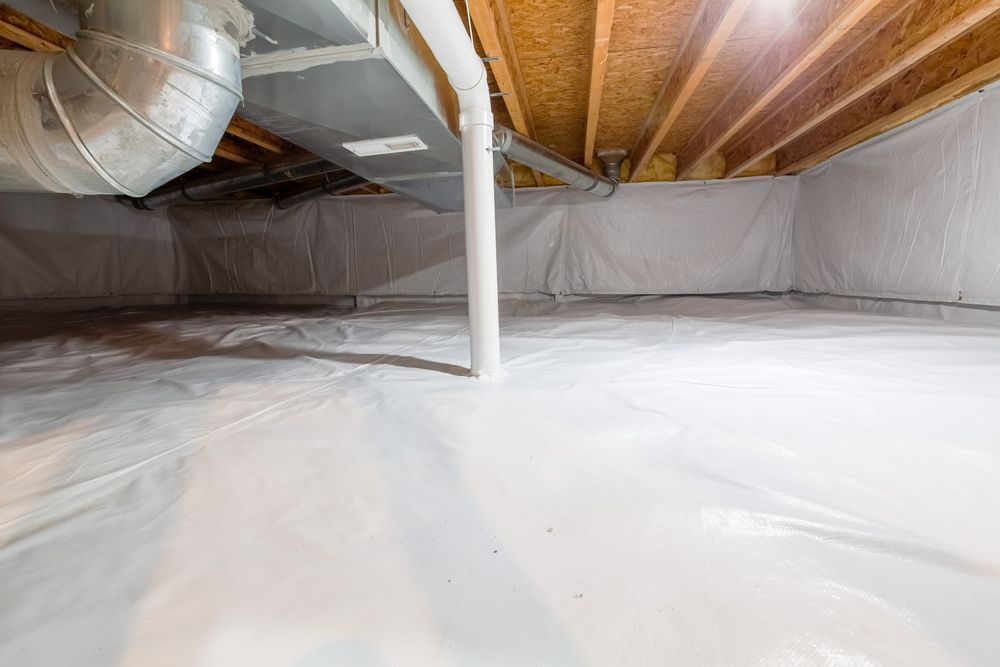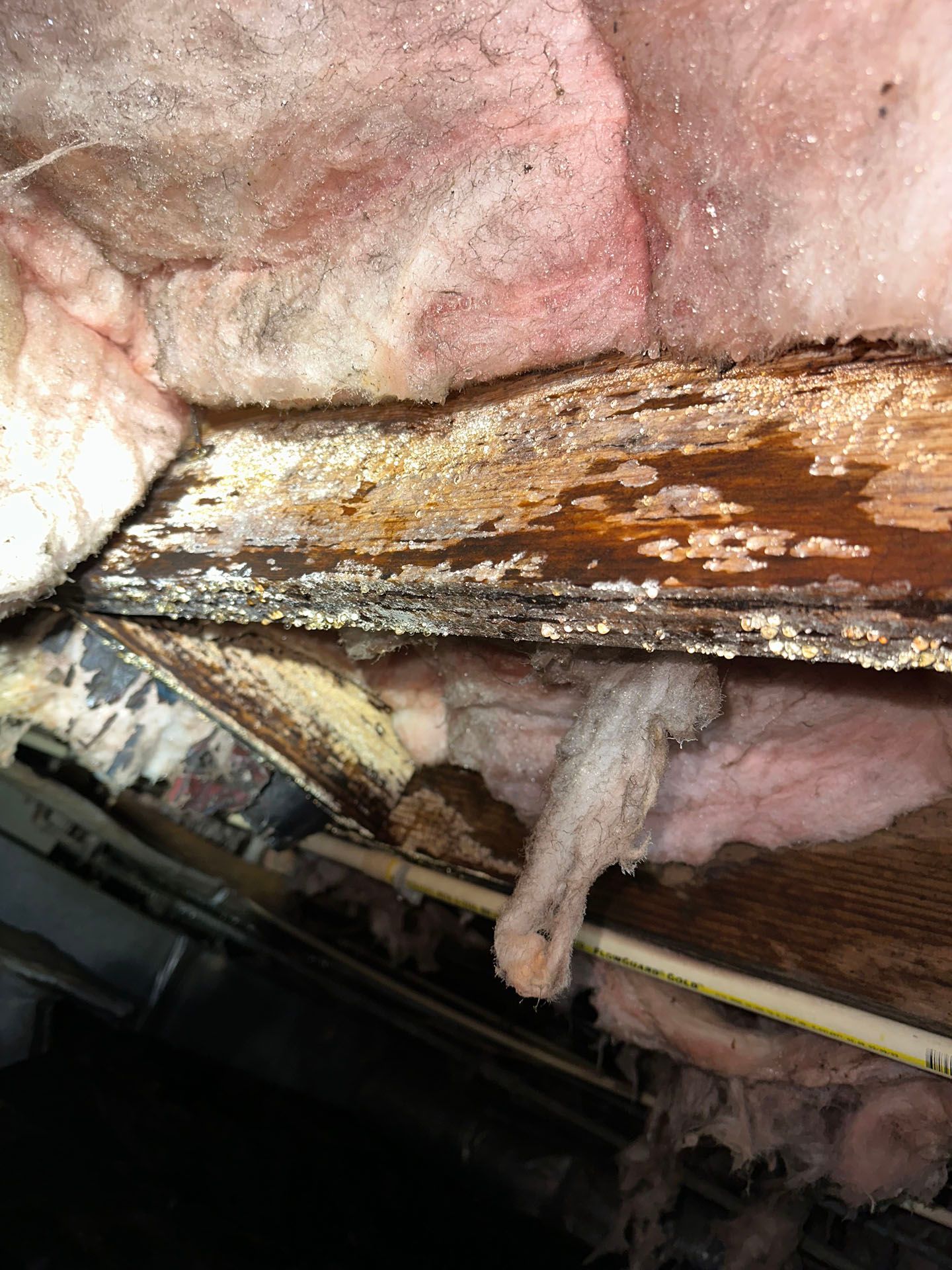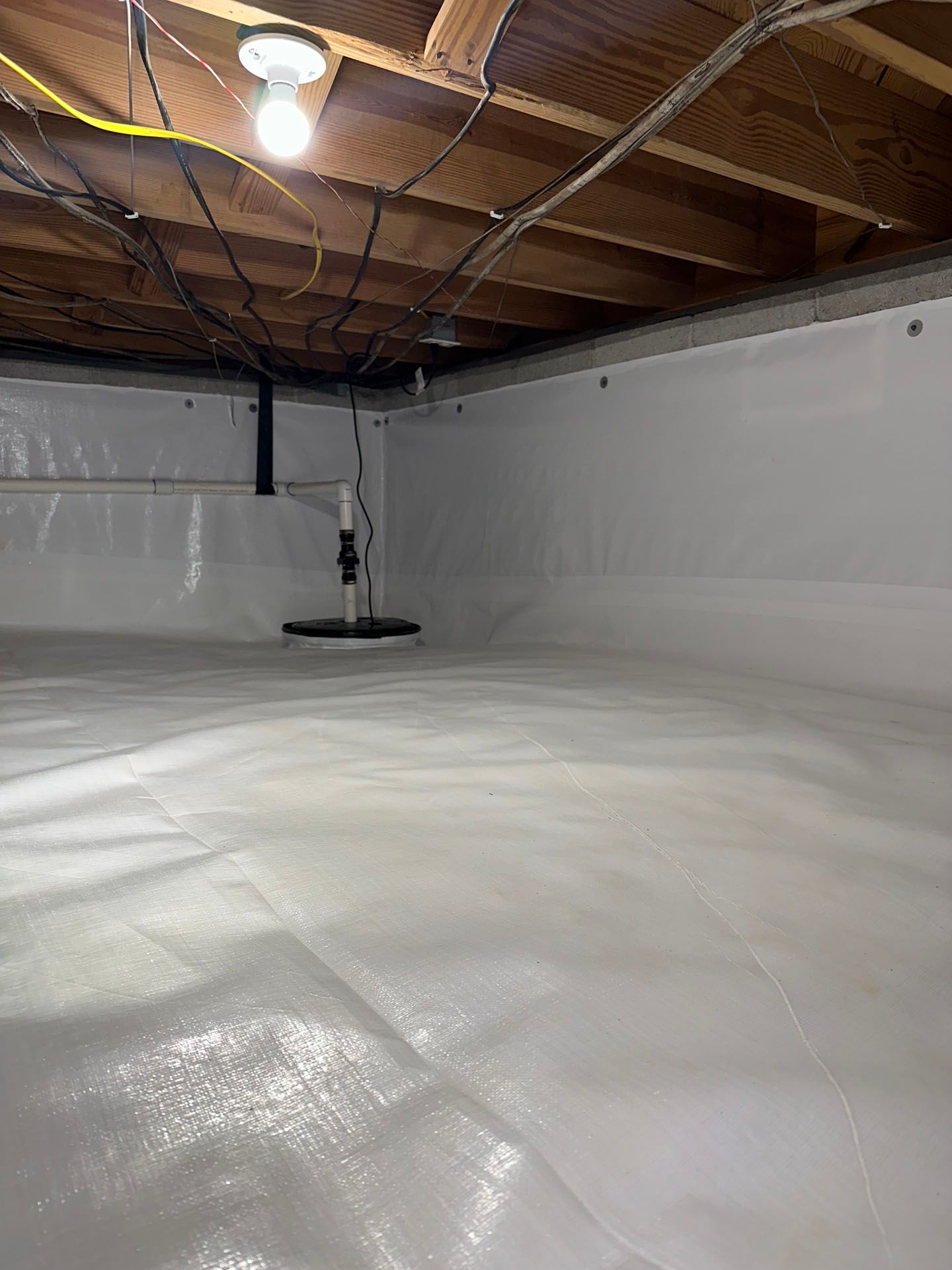Huntsville, Alabama

Claim Your FREE Crawl Space Inspection Today!
Sawyer Williams: 256-727-4422
Schedule Your Free estimate!
No-Obligation, Free Inspections
No-Obligation Free Estimates
We Warranty All of Our Work
100% Satisfaction Guaranteed
If you’re thinking of encapsulating your crawl space, you’re not alone. Many homeowners have heard about the advantages of crawl space encapsulation and are wondering if it’s really worth the time, effort, and cost. After all, there are some potential risks associated with any homeowner project, and encapsulating crawl spaces is no exception.
So is crawl space encapsulation safe? In this post, we’ll take a look at the potential benefits and risks associated with encapsulating a crawl space in your home, helping you make an informed decision about whether or not it’s the right choice for you. Let’s get started!
Quick Explanation
Crawl space encapsulation is generally considered to be a safe and effective way to protect your home from moisture and other hazards associated with an unencapsulated crawl space. Proper installation of the encapsulation materials can help extend the life of your home’s structure and provide cost savings in the long run.
What is Crawl Space Encapsulation?
Crawl space encapsulation is the process of completely sealing the structure to prevent moisture and humidity from entering, while decreasing energy costs. It involves waterproofing the walls, adding a layer of plastic sheeting along the floor, installing air tight seals on all vents, and finally installing a dehumidifier. This is a dramatic shift away from the traditional, open-vented crawlspace approach that has been used for decades.
Some argue that this modernized approach is too costly for homeowners in terms of both money and time. In some cases, it's necessary to tear up walls and flooring, as well as rip out existing insulation. Additionally, when done properly, crawl space encapsulation requires ongoing maintenance checks to make sure it remains functional.
However, many believe that these risks are worth taking due to the potential long-term gains of improved indoor air quality and decreased energy consumption. Crawl space encapsulation can dramatically increase your home's comfort level by keeping outside elements and pests at bay while reducing energy bills. Furthermore, since it prevents moisture buildup which can lead to mold growth, encapsulating your crawlspace can also help reduce health issues caused by contaminants in your home’s air.
For those considering crawl space encapsulation, it is important to weigh both sides of the argument before making a final decision. The investment can be significant in terms of time and money but there is potential for future savings on energy bills and health-related costs associated with mold and other contaminants. Ultimately, it is up to each individual homeowner to decide if the benefits outweigh the risks when it comes to their own specific situation.
With careful consideration being given to both sides of the debate, it's clear that there are many benefits to be gained from crawl space encapsulation. In the next section we will discuss further what these benefits might look like in detail and how they may impact your overall home environment.
Must-Know Summary Points
Crawl space encapsulation is an effective way to improve your indoor air quality and decrease energy consumption. It involves waterproofing the walls, adding a layer of plastic sheeting, seals on vents, and a dehumidifier. Although it is costly in terms of money and time, it can lead to long-term savings such as reduced energy bills, improved health due to mold prevention, and increased comfort levels. Weighing the risks and benefits must be done before making a decision.
Benefits of Crawl Space Encapsulation
Crawl space encapsulation offers a variety of benefits, many of which can contribute to greater home comfort, health and energy efficiency. Sealing the crawl space helps regulate temperature and humidity within the living space of the home. This will help make the interior more comfortable year-round and can reduce monthly heating and cooling costs by preventing heated or cooled air from leaking into the basement or crawlspace environment. This also allows for improved air quality, as environmental pollutants in the crawlspace have less opportunity to enter living spaces via the HVAC system.
In addition, sealing the crawl space with an impermeable vapor barrier keeps moisture from accumulating inside and reduces the risk of mold growth. Moisture in the crawl space creates a prime environment for mold growth, as well as dust mites, insects, and other pests. By preventing these organisms from establishing a foothold in your home, you can help keep your family healthy.
Despite these clear benefits, some people may question whether it is necessary to encapsulate a crawl space at all. But it’s important to remember that sealing off this otherwise-unused area of the home significantly reduces the risk of moisture accumulation and mold growth; both of which can cause expensive damage if left unchecked. Furthermore, investing in sealant will potentially save money on energy bills over time while improving indoor air quality, so it may be worth considering if your home isn't already sealed off this way.
Encapsulating a crawl space is a great way to eliminate potential problems associated with moisture accumulation and improve overall health and comfort in your home. In our next section we'll look at how properly encapsulating a crawl space can protect the home from moisture & mold damage.
Protects the Home from Moisture & Mold Damage
Crawl space encapsulation is widely seen as an effective means of protecting a home from moisture and mold damage. It does this by providing a barrier that prevents water vapor from entering the space, leading to an overall more stable environment that limits the risk of fungi growth. The process also helps to better insulate the crawlspace itself, reducing the chances of cold air seeping into the living areas of the home and increasing energy efficiency.
When done properly, crawl space encapsulation can significantly reduce or eliminate mold infestations. It is important to remember, however, that an encapsulated crawl space does not guarantee that all moisture and fungus problems will be eradicated from a home. If there are existing plumbing leaks or an improper drainage system in place, these problems must be resolved before encapsulation can produce any lasting results. Additionally, it may not be feasible to seal off each area of the crawlspace entirely depending on certain structural considerations. In such cases, partial encapsulation might be necessary in order to adequately protect the property.
Overall, while effective when done correctly, crawl space encapsulation has its limitations and cannot guarantee perfect protection against moisture and mold damage; nonetheless, its benefits far outweigh any risks if it is carried out properly by experienced installers. This leads nicely into our next section which looks at how crawl space encapsulation prevents air leaks and traps condensation within the structure of a home.
Traps Condensation and Prevents Air Leaks
Crawl space encapsulation effectively traps condensation and prevents air leaks from the outside to the inside. This process of sealing off the crawl space helps to maintain the quality of the air in your home. According to research, most air leaks into a home come from the crawl space, accounting for up to 20-30% of all air leakage in a home. By encasing the crawl space with an airtight seal, you’re able to drastically reduce the amount of uncontrolled conditioned air being pulled out from the structure and lower your home energy costs at the same time.
This type of encapsulation can also help protect against future moisture problems by blocking any humid or damp air coming through gaps, holes or vents in your drywall. If this damp air is left unrestricted and allowed to enter your living space it can potentially damage wood structures, furniture and other items in your home. By sealing off these vulnerable areas, you’ll also be able to prevent mold growth that could occur if there was high levels of humidity present in your crawl space or attic area.
On one hand, proponents claim that crawl space encapsulation is a highly effective solution for reducing energy costs while protecting indoor spaces from mold and humidity buildup. They point out that this process requires minimal effort and has been proven to work well in instances where chronic moisture problems were present. On the other hand, those who are skeptical fear that by creating an airtight environment, dust, dirt and allergens may become trapped within the framework which could result in breathing difficulties and create an unsafe living condition for inhabitants within the home.
Regardless of what opinion you may hold about crawl space encapsulation, it's important to understand that proper insulation plays a major role when it comes to creating an ideal indoor environment. The next section will discuss how this type of insulation ensures quality air throughout all areas of your home.
Ensures Quality Air throughout the Home
Ensuring quality air throughout the home is one of the main benefits of crawl space encapsulation. It helps to create an environment that is free from allergens, contaminants, moisture, and even pests. By putting a layer of plastic or other material over a crawl space, it can create a physical barrier between the interior of the home and the outside environment. This barrier helps keep out dust, dirt, mold spores, and any other environmental contaminants. Additionally, when the area is properly sealed off and insulated, it creates an environment where moisture cannot build up and condensation will not occur.
However, there are also risks associated with crawl space encapsulation that should be noted before undertaking this project. It is important to ensure that proper ventilation is available in the crawl space so that air does not become stagnant. If proper ventilation isn't installed, then this may lead to poor indoor air quality as well as mold growth due to the accumulation of humidity levels in the area. Additionally, if not done correctly some materials used in crawl space encapsulation may contain volatile organic compounds (VOCs) that could be released into the air and breathed in by inhabitants of the house.
Therefore it is important to weigh both the benefits and risks of crawl space encapsulation when considering whether or not it is safe. The next section will look further into this topic and discuss whether or not crawl space encapsulation is actually safe for homeowners to undertake.
Is Crawl Space Encapsulation Safe?
This is a question that homeowners ask themselves before they make any changes to the foundation and structure of their home. On the one hand, many people are worried about possible risks associated with this type of work. On the other hand, there are certainly significant benefits to be gained. Understanding the potential risks and benefits can help homeowners make an informed decision when it comes to crawl space encapsulation.
One potential risk of crawl space encapsulation is that it can lead to unhealthy levels of moisture build-up in certain parts of the house. If the home has poor drainage and ventilation, too much humidity can quickly become an issue, inviting mold growth and encouraging unhealthy air quality overall. Additionally, if the crawl space is not properly insulated, energy efficiency may suffer. Finally, crawl space insulation materials used need to be carefully selected for safety reasons; if flammable materials are used or applied incorrectly, fire hazards could result.
Despite these risks though, there are several important benefits related to crawl space encapsulation. By sealing off the area from outside air and moisture intrusion, homeowners can greatly reduce their risk for things like insect infestations and other forms of damage due to water penetration. Plus, researching the right types of encapuslation materials and installing them correctly can do a lot to improve air quality, reduce allergens, and improve energy efficiency by keeping conditioned air within the living area where it belongs.
Overall, homeowners should take great care when considering crawl space encapsulation as they need to consider both the potential risks and rewards before deciding on any course of action. To explore these issues further and eliminate any health or safety concerns prior to starting an encapsulation project, consulting with experienced professionals is recommended.
Having discussed some of the key issues related to crawl space encapsulation safety, we should now move on to look at some of the materials used in encapsulation projects. The next section will provide a comprehensive overview of all the materials available for use in various crawl spaces around the country.
The Materials Used in Crawl Space Encapsulation
The materials used in crawl space encapsulation are key to its efficiency and cost, however, the choice is largely up to the homeowner for their particular needs. Some methods of encapsulation only require plastic sheeting, which is relatively inexpensive. But other methods may require specialized products like foam board insulation and reinforced vapor barrier which can be more costly, however they are better suited meeting the particular requirements needed for air tightness while providing a clean, dry storage area.
Both sides of the argument have some validity when it comes to the use of encapsulation materials. On one hand, there are the plain plastic sheeting options that keep out moisture but lack durability or tear resistance. This option is much less expensive than specialty products but may need to be replaced more frequently. On the other hand, investing in quality products can save on cost over time because it will last longer without requiring frequent replacements.
The variety of materials available for crawl space encapsulation also allows for additional installation options such as water drainage systems and humidity monitoring instruments to create an optimum environment for everyone’s needs. Ultimately, each choice should depend on the desired outcome and budget limitations associated with each project.
No matter what option you choose, it's important to ensure that your crawl space is completely sealed off from any external sources of moisture and cold air in order to protect your home and preserve indoor air quality. The next section provides information about crawl space encapsulation installation, regardless of which materials are chosen for the project.
- According to a study published in 2020, properly sealed crawl spaces can reduce moisture levels by as much as 99.8% and humidity levels by up to 72%.
- Crawl space encapsulation has been found to reduce major pest infestations by as much as 94%.
- Another study found that crawl space encapsulation can improve the indoor air quality of a home by up to 68%, making it significantly healthier to live in.
Crawl Space Encapsulation Installation
The installation of a crawl space encapsulation system requires professional expertise, as it needs to be done in order to ensure that all areas are properly sealed and moisture is kept out. Depending on the type of system installed, there can be a variety of materials used, such as plastic sheeting, insulation, and drainage systems. The type of system that should be installed is dependent upon the climate, soil condition, water infiltration rate, and other factors.
Regardless of the type of system installed, crawl space encapsulation installation involves preparing the surface for installation of the material. This typically includes removing any debris or vegetation from the area and then laying down a plastic vapor barrier along the floor and walls to act as a moisture barrier. Once this is in place, insulation can then be installed prior to sealing off any seams or cracks using caulk or expanding foam.
Finally, drainage pipes and sump pumps may need to be installed depending on the local climate—these parts will help collect any moisture from the surrounding soil and prevent it from entering the living area. During installation, care must be taken to ensure that all piping enters outside or is otherwise properly vented to prevent mold buildup.
The benefits of installing a crawl space encapsulation system are numerous; however, some experts argue that these systems don’t address underlying problems with foundation settlement or other potential issues like bugs and pests. While an encapsulated crawl space will help keep moisture levels in check, it should not be seen as a substitute for regular maintenance and inspections—it is only one piece of the puzzle when it comes to keeping your home safe and healthy. With proper installation and regular maintenance, a crawl space encapsulation system can provide many years of protection against moisture buildup.
In conclusion, while there are risks associated with installing a crawl space encapsulation system due to potential problems that could arise from improper installation or long-term damages from water infiltration, there are also many benefits associated with these systems. Properly maintained systems can help reduce energy costs by providing better air circulation in your home, reduce mold growth in moist lower areas of your home such as basements and crawl spaces, help keep out insects and other pests who love damp environments, and increase indoor air quality overall. With this in mind, it's important to remember that maintaining proper ventilation is essential for keeping your home healthy and dry—something that both installing an encapsulation system successfully installs as well as regular maintenance can help achieve.
Next we will discuss the importance of Crawl Space Encapsulation Maintenance and Repair in order to ensure your system continues working effectively over time.
Crawl Space Encapsulation Maintenance and Repair
Crawl space encapsulation maintenance and repair can be thought of as a rewarding investment, however it is important to understand the risks and benefits associated with this process.
When it comes to crawl space encapsulation maintenance and repair, there are a few things to consider. First and foremost, the cost associated with these tasks should be understood. The process of maintaining your crawl space requires regular inspection and any repairs that need to be made. While this may seem like an added expense up front, it can often save you money in the long run by preventing costly issues such as mold or rot repair. Furthermore, this proactive approach to crawl space maintenance also helps to extend the life of your home's insulation, air systems, and other components of the home.
In terms of structural concerns associated with crawl space encapsulation repair, pros recommend that homeowners consult a structural engineer if they notice any anomalies or concerning signs between inspections. Ensuring that repair work is done correctly is particularly important for crawl spaces due to their accessibility, as even minor issues can become major problems quickly if left unattended. Furthermore, moisture levels must always be kept in check in order to maintain the health of your home’s foundation and its underlying structure.
Lastly, it is wise to have periodic evaluations completed by a licensed pest control expert due to the prevalence of pests in enclosed spaces where moisture is often found. These periodic evaluations will enable homeowners to stay ahead of any potential pest threats on a regular basis rather than waiting until it's too late.
In general, crawl space encapsulation maintenance and repair are best left to experienced professionals whenever possible due to the complexity of these tasks and the fact that improper care may pose significant risks such as water damage and structural degradation. With that said, when executed properly these tasks are essential for safeguarding your home against costly damage from pests and moisture over time.
Answers to Frequently Asked Questions with Detailed Explanations
What are the benefits of crawl space encapsulation?
Crawl space encapsulation has many benefits, including improved air quality, energy savings, decreased risk of mold and mildew growth, and enhanced structural integrity.
Improved Air Quality: Crawl space encapsulation helps to keep moisture from entering your home’s living spaces. This reduces the allergens and pollutants in the air, meaning fewer respiratory health issues for those living in the home. It also helps to reduce dust, pollen, and pet dander circulating through your vents.
Energy Savings: Encapsulating your crawl space helps to keep the appropriate temperature inside your home year-round. That means less energy lost and lower utility bills for you!
Reduced Risk of Mold & Mildew Growth: The extra barrier provided by crawl space encapsulation helps to protect against the growth of mold and mildew. Not only is mold unsightly but it can cause health problems as well as damage to your home’s structure and furnishings.
Enhanced Structural Integrity: The extra protection offered by crawl space encapsulation helps to support the foundation of your home. The improved strength and stability can help prevent cracks in walls or floors as well as other potential long-term problems with your foundation.
What safety precautions should be taken when performing crawl space encapsulation?
When performing crawl space encapsulation, it is important to take the necessary safety precautions to ensure that the job is completed safely and correctly. The most important things to consider when protecting against risk are:
1. Ensure proper ventilation - Proper ventilation helps prevent the buildup of moisture, which can lead to mold and other harmful organisms in a crawl space. Make sure that proper ventilation is installed during the encapsulation process in order to keep the air quality of the area safe and healthy.
2. Wear protective clothing and equipment - When performing crawl space encapsulation, it is important to wear protective clothing such as gloves, masks, and boots in order to avoid potential contact with hazardous substances including pesticides or harsh chemicals used in product application. Other protective equipment such as goggles should also be worn if needed.
3. Follow manufacturer's instructions - Before installing any products related to crawl space encapsulation, make sure you read the manufacturer's instructions thoroughly and follow all safety precautions listed on the product label to avoid potential hazards associated with use or installation of these products.
4. Monitor air quality - Because crawl spaces tend to be often damp, dark places, they can easily become breeding grounds for airborne toxins and bacteria. Therefore, it is important to regularly monitor air quality within your crawl space using an air-quality monitor in order to detect any harmful conditions in your environment caused by encapsulation system breakdowns or other factors.
What are the negative impacts / side effects of crawl space encapsulation?
The potential negative impacts/side effects of crawl space encapsulation depend on how and where it is done. These risks can include a buildup of moisture that can lead to mold and mildew, as well as an increase in humidity. A poor installation job might also create air leaks and drafts that can lower the energy efficiency of the building. Moreover, if the person performing the encapsulation does not take health safety precautions like wearing proper respirators, there is a risk of inhaling toxic fumes from the materials used in the installation process. In short, proper installation techniques must be adhered to and precautionary measures should be taken in order to minimize any potential negative side effects.

Written by Sawyer Williams
Precision Crawlspace & Renovations
Sawyer has specialized in crawl space and foundation repairs for over six years. As the founder of Precision Crawlspace and Renovations, he is one of Huntsville's top experts in crawlspace moisture control. He has prior experience installing these systems, which has prepared him to solve complex problems related to crawl space encapsulation, mold remediation, and waterproofing.
Recent Blog Posts
Huntsville's Crawl Space News



What are you waiting for?
We Solve Crawl Space Issues!
Get reliable crawl space repair services at an affordable price, provided with the high level of service you deserve.
Call Us Today at: 256-727-4422
All Rights Reserved | Precision Crawlspace & Renovations

